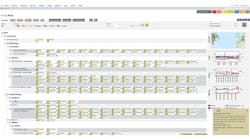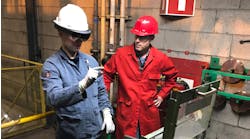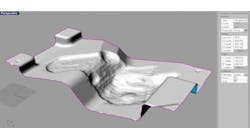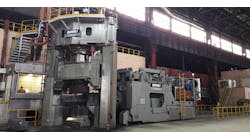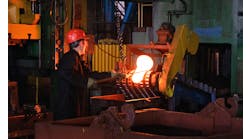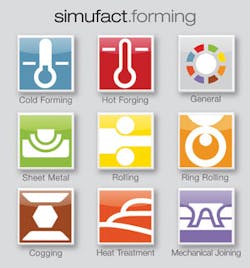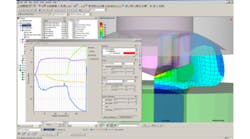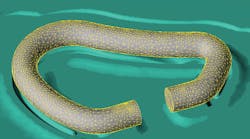Forging metal parts is possibly the oldest industrial process in continuous use, and thanks to the rapid evolution of simulation technology, new understanding about the forging process is emerging on a regular basis. More important, the various details of the new understanding are not confined to the program developers: because of the increasingly personalized nature of information technology, forgers, designers, and others are able to make their own discoveries.
That means the discoveries are not dependent on the arrival of new versions of simulation software programs. Simufact issued its most recent update to its forging simulation program, Simufact.forming 12 in January – and one feature of that release is Applied Function Sets, or AFS. According to Volker Mensing, marketing director for Simufact, software users have been enthusiastic about the utility of the AFS approach.
AFS allows the user, once launching the Simufact.forming program, to decide on a specific field of application. Process-dependent setups, e.g., selecting an appropriate solver, are displayed, and specific functions for other application fields are hidden. As a result, the functions for hot forging are bundled and the software limits itself to the process-relevant functions.
This significantly improves the usability of the software, streamlining decision-making and simplifying the overall project. More than that, Simufact.forming becomes more intuitive for each user, faster and more effective. And, because the program can be applied for hot forging, cold forming, sheet metal forming, rolling, ring rolling, open-die forging, heat treatment and mechanical joining processes, the variety of expertise available to users is amplified.
In one recent demonstration, Simufact emphasized how the software can be used to avoid typical manufacturing defects, such as the “fold formation” on a component.
This defect is particularly relevant for cold forming, with impact on finished part quality and on tool life. The characteristic yield stresses and the material hardening of cold forming require high pressing force, which exposes the forming tools. Often, tool resistance can only be attained by a supporting reinforcement.
So, cold forming simulation has to account for all such conditions, including the tool reinforcement and the material flow. And, a realistic presentation of these forces is necessary for high-precision simulation of cold forming, while taking into account the effects of spring back and the elastic-plastic material laws – all features that are provided by Simufact.forming.
The AFS technology bundles together the cold-metal forming functions, and the limits to the process-relevant functions. From a customer’s point of view, simulation software supports efforts to find answers to urgent matters. Simulation-based feasibility studies show whether or not a component ordered by a customer can be realized.
Evaluating Different Approaches, Simultaneously
For those striving to avoid mistakes in the series production, process simulation is indispensable for evaluating different manufacturing approaches simultaneously, to differentiate between good and bad approaches and to select the most suitable one. This sort of experimentation would be significantly more expensive in real-life testing, but even without the experimental objective, simulation can be used to reduce the number of trial runs that a manufacturer must conduct. Virtual testing also can be used to predict the results of multistage manufacturing.
Other simulation software developers are promoting a greater user experience, too. FORGE®, the hot- and cold-forming simulation software offered by Transvalor, introduced a new graphical interface recently. “The new package is based on a completely customizable and extendable architecture, and uses modern technology to provide each trade and each user with an appropriate environment in which to unroll its preferred workflow,” according to Dr. Andres Rodriguez-Villa, now a senior advisor in software architecture.
Rodriguez said the developers took special care to provide more material processing know-how when needed in the interface.
Also new, and also emphasizing the new value of the user experience, is QForm7, the updated forging simulation program developed by QuantorForm Ltd. Introduced in 2013, it presented an entirely redesigned interface, data structure, and algorithms written with modern programming techniques that the developers explained allow more power and flexibility than before. The new program runs significantly faster too, thanks to more advanced algorithms and full parallelization of the computations.
The developers of QForm7 state that the new program offers a balance of high-performance, flexibility, speed, and accuracy, with a quick learning curve for new inexperienced users while allowing for profound analysis capabilities for the most advanced users and researchers. It remains easy to use, with familiar features of the previous version of QForm, including 2D and 3D problem simulation; detection of laps, flow through, and non-fill defects, as well as full tool simulation capabilities including die stress and die wear.
As for new features, QForm7 offers new algorithms for solving coupled mechanical and thermal problems, where the temperature and deformation of the dies are calculated concurrently with the simulation. It has both explicit and implicit solvers, as well as elastic-visco-plastic formulation that allow for simulation of residual stresses and distortion. The software’s developers claim QForm7’s new methods are so effective that an entire press structure can be included in a simulation coupled both thermally and mechanically with the deformation of the billet and the dies.

